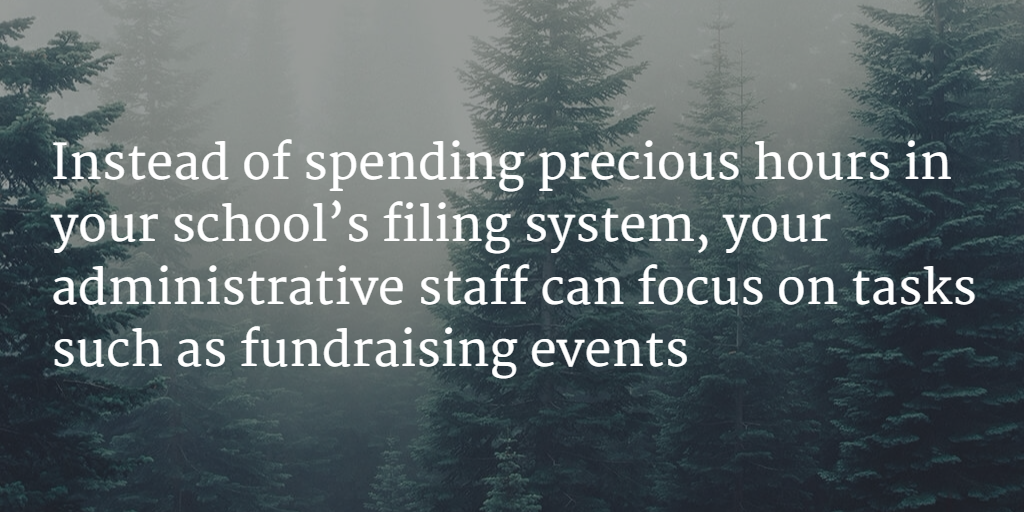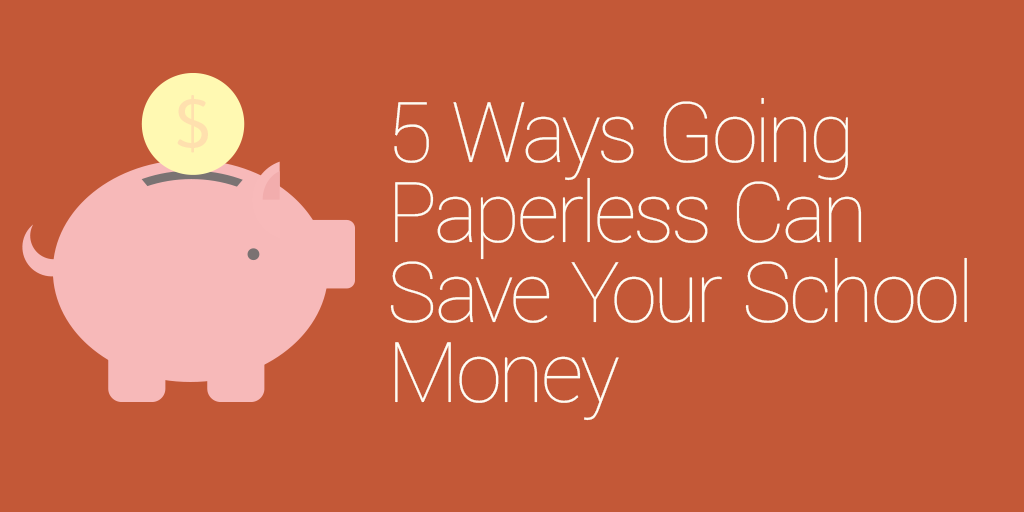We’ve all been feeling the effects of deep budget cuts that seem to get worse every year.
While it’s not your preference to cut extracurricular programs, field trips, and the salaries of your brightest teachers, fiscal constraints may not spread money around your school’s budget the way you want.
But before cutting the Astronomy Club, consider an overlooked expense that many schools believe they can’t reduce: paper and printing supplies.
Sure, paper may not seem costly on a day-to-day basis, but over the course of a year it can really add up.
We’re also talking about the supplies that go along with printing on that paper; expensive machines that always need servicing and ink and toner that need frequent replacing.
Let’s not forget that you have to hire additional staff to organize the seemingly endless mounds of paper.
To put these numbers in perspective, consider this example from Yale University.
“In FY 2011, the University consumed 211,033 reams of paper, according to the Office of Sustainability—that’s enough paper, if laid end to end, to stretch three-quarters of the way around the earth.”
And how much did this cost the university?
“The University spent roughly $680,000 on copier paper and twice that amount on toner,” for a grand total of approximately $2,040,000.
Now, your school may not be as large as a university, but even if it consumed a third of the paper Yale did, we’re still talking about 70,337 reams of paper for a whopping $679,000 in supplies alone.
This figure does not account for the administrative staff that’s required to organize and sort through 70,000+ reams of paper, either. When you add those costs in, your final paper and printing budget number is much higher.
The cost for a smaller K-12 school may be closer to around $250,000 per year.
Imagine what your school could do with an extra $250,000 each year if you went paperless.
You may not have even considered going paperless at your school, but today’s article will show you why making the switch to paperless will save your school a small fortune.
As an added resource, you can download our handy worksheet which can help you calculate just how much using paper is costing your school.
[content_upgrade cu_id=”2043″]How much money are you wasting by avoiding going paperless? Find out here![content_upgrade_button]Click Here[/content_upgrade_button][/content_upgrade]
1.Save Money on Costly Supplies
For our purposes, we’ll be using a smaller-sized school in our examples, one that may spend closer to $250,000 on paper and printing supplies per year.
Let’s break down how we got to this figure first:
- Leasing a sophisticated printer: $30,000- $50,000 per year
- $25,000 on the paper alone (approximately 25,000 sheets, 50 reams of paper)
- $7,500 in ink and toner supplies
Assuming that the leasing of a printer costs $50,000 per year, these numbers alone add up to $82,500 in supplies.
Now let’s combine this figure with the cost of hiring an administrative staff to organize and file this expensive paper.
2. Save Money on Administrative Staff
Since many schools are unable to find an all-volunteer staff of parents, they must hire administrators to file and retrieve important paper forms.
With a yearly printing budget of $250,000, a typical school could afford to hire at most six administrative assistants (assuming their salary is approximately $27,000 which is the average salary as reported by Payscale).
[Here’s how we calculated this. We took the $250,000 budget and subtracted $82,500 in supplies to come up with $167,500 for payroll. We divided this number by an average salary of $27,000 to come up with approximately six employees.]
If the average salaries are higher in your town, then your school may only be able to afford 3-5 employees to handle the organization of files.
See how quickly this adds up?
This expense should be reduced to allocate revenue towards money-generating expenses instead.
Now that we’ve seen how using paper adds up, we should also consider the amount of time it takes to use and process paper forms.

3. Save Time
Let’s follow the paper trail and see how it works in action at your school.
A typical health form for every student needs to be printed, mailed, and returned to the school to keep on file.
Your administrative staff needs to physically take in all those paper forms, file them in an organized system, and know how to retrieve them later on.
So what if you’re looking for information about how many students have nut allergies?
Since files are typically organized by name, not by allergy, your administrative staff member will have to physically go through each student file to find those with allergies to nuts.
Then they have to put all of these files back one by one. Talk about time consuming.
However, if your school was using digital forms, this whole process would have been completed in less than a minute with a simple search.
So instead of spending precious hours in your school’s filing system, your administrative staff can focus on tasks such as fundraising events, which can help bring in more income for your school.
4. Save on Storage
Space isn’t easy to come by in schools, especially older schools that have seen increasing student numbers, but not expanded square footage to accommodate them. Therefore, every square inch must be carefully used.
One area that’s costing you space—our guess is approximately two small offices worth of space—is your printing supplies.
Between the massive printer itself and the number of supplies it takes to achieve a decent volume discount, we’re talking at least one room dedicated just to printing.
Then you have to organize all of that paper in bulky, expensive filing cabinets, which probably take up another small office. This may be a total waste if your school’s short on space.
5. Minimize the Risks Associated with Paper
Think about how much information you keep on your computer or phone instead of using little notes all around your home and office.
Why do you do this?
Probably to keep all of your important details organized in one secure location, right?
On a day-to-day basis, especially when several hands are managing a single form like a field trip waiver, the chance of misplacing that important paper is extremely high.
Not to mention that papers are easily damaged in book bags and bus rides along the way.
But they’re not safe when they get to school either. What would happen if Ms. Neptune let her science lab get a little creative and one of the experiments triggered the fire alarms and sprinklers to engage?
Your entire organizational system could be destroyed in a matter of minutes.
Digital forms take away that risk since they can be backed up and stored safely.
[content_upgrade cu_id=”2043″]How much money are you wasting by avoiding going paperless? Find out here![content_upgrade_button]Click Here[/content_upgrade_button][/content_upgrade]
Digital Forms Save Time and Money
Spending tons of money on paper forms and printing supplies every year really costs your school time and money that you’ll never see a return on.
By switching to digital forms, your administrative staff will be able to efficiently file and retrieve information by navigating a simple spreadsheet or website.
Which means they’ll be available to work on fundraising activities to earn your school much needed funds.
Plus, all of your students’ confidential information will be backed up and kept secure. You’ll never worry about papers accidentally walking out of the office in a heap of forms again.
Make the jump to paperless and save your school time and money today. Find out how Hubbli can make this switch seamless for your school.

